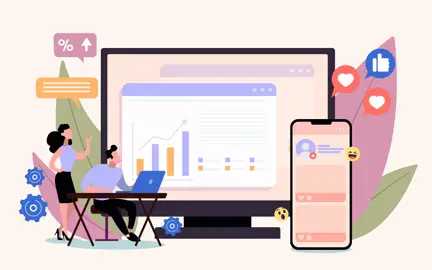100+ The opportunity to introduce the job of the Category Marketing / Advertising
Hiring High-Paying Marketing & Advertising Roles | Aniday
1. What is Marketing?
Marketing is the process by which businesses provide value to their clients and cultivate enduring relationships to obtain value from them in return.
Marketing’s Goal: is to generate interest in the goods or services that the business offers. This is accomplished by studying the target client’s interest and conducting market research and analysis. All facets of a firm, such as product development, sales, promotion, and distribution strategies, are included in marketing.
When individuals began endorsing products through media other than print in the 1950s, modern marketing had its start. With the introduction of TV and the internet into homes, marketers can run complete campaigns on a variety of media. In the past 70 years, marketers have played a bigger role in optimizing a company's success by fine-tuning how it offers products to customers. Drawing customers to the brand through messaging is the core goal of marketing. The message should ideally be instructive and beneficial to the target audience to turn them into leads.
2. What are the differences between Marketing and Advertising?
Advertising is one spoke of a wheel if marketing is a wheel.
Product development, market analysis, product distribution, sales tactics, public relations, and customer service are all included in marketing. All phases of a company's sales process require marketing, which can utilize a variety of platforms, social media accounts, and internal teams to pinpoint its target market, connect with them, amplify its message, and gradually foster brand loyalty.
However, marketing consists of much more than just advertising. Advertising is the process of crafting and releasing messages to support a good, service, or concept. As part of the more comprehensive objectives mentioned above, it is a calculated, typically paid-for strategic attempt to raise awareness of a good or service. In other words, it's not the exclusive strategy employed by marketers to promote a product.

3. How many types of marketing?
Where clients spend their time determines where the marketing initiatives will run. It is the marketer’s responsibility to carry out market research to ascertain which marketing strategies—and the combination of instruments within each strategy—are most effective in establishing the brand.
There are two approaches in marketing with diverse forms in each, which are traditional and digital marketing:
Digital Marketing: Digital marketing utilizes online channels like social media and websites to promote to a large audience. It has expanded rapidly driven by technological improvements and newer media trends. The technique is very effective as people spend considerable time online, enabling millions of digital ads to be viewed shortly.
a. Content Marketing
An efficient inbound marketing tactic is content marketing, which informs and engages consumers by assisting them in finding internet resources about their goods, company, or sector. Here are some instances of content marketing:
- Blogs
- Organic Social media posts
- E-book
- Video
Content marketing aims to give clients the information they need to make informed purchasing decisions.
b. Social media marketing
There are times when social media marketing is viewed as a minor component of content marketing. Nonetheless, numerous marketers think social media is a separate marketing strategy that needs more focus. Social media is an affordable marketing tool that may help businesses sell more things, educate customers, and foster audience participation.
With diverse available platforms, there are various social media marketing strategies, though some may better suit objectives. B2B is more suitable on Facebook and LinkedIn than Instagram and YouTube. Meanwhile, visual-reliant businesses like e-commerce perform better on Facebook, Instagram and TikTok. However, marketers can reach audiences anywhere with a solid plan.
c. Influencer Marketing
Influencer marketing is viewed as a distinct strategy by some and as a subset of social media marketing by others. Businesses can benefit from the connections influencers and opinion leaders have already established with audiences by utilizing influencer marketing.
Influencers are thought leaders in their fields, whose followers are inclined to heed recommendations for products since they have earned a degree of trust that many firms would never achieve. Influencer marketing can therefore assist the brand in gaining more visibility, raising brand recognition, and boosting sales.
Influencer marketing is popular for e-commerce companies. However, B2B businesses can also gain from partnering with influential thought influencers with a large audience base.
d. Search Engine Marketing
All forms of marketing that leverage search engines like Google as a tool for promotion are collectively referred to as search engine marketing (SEM). Generally speaking, search engine marketing consists of two digital marketing techniques.
- Search engine optimization (SEO): a marketing tactic that helps the company improve the website's content to rank higher on search engines.
- Pay-per-click (PPC): is an additional search engine marketing tactic that promotes the company's website on search engine results pages. Nevertheless, instead of appearing at the top or bottom of the SERP in the organic results section, their website will now appear in the sponsored search results section. Whereas SEO concentrates on organic traffic, PPC demands marketers to pay for each click. Both strategies work well for increasing website traffic.
SEM is now mostly connected to PPC, whereas SEO is now considered a stand-alone tactic.
Because so many individuals start searching for answers on search engines, SEM can be advantageous to any kind of business. Therefore, SEM may be used by both B2B software companies and B2C e-commerce businesses to expand their customer base and boost website traffic.
e. Email Marketing
Due to its great effectiveness, email marketing is used by many businesses. To boost sales and facilitate customers' progress through the sales funnel, marketers must send emails to both current and potential clients. High returns are correlated with high conversion rates.
Fact: email marketing gives a high ROI of $40 per every dollar spent
Getting consumers to subscribe to the company’s emails is a must for email marketing, which could take some time. Nevertheless, once they have subscribers, they can use drip campaigns and a variety of emails to guide them down the funnel. These may include notifications about abandoned carts, new product releases, and even newsletters. Learn about the email marketing customer journey before they begin crafting their emails to see how automation might boost revenue.
Both B2B and B2C can use email automation to enhance sales. B2B focuses on maintaining prospects while B2C emphasizes quick transactions.
f. Public relations
One kind of marketing that might help businesses establish their reputation in the media is public relations (PR). Through earned media, public relations helps manage a company's reputation and image by fostering positive relationships with the public. Eventually, PR seeks to establish the business, raising brand awareness and fostering public trust.
Although maintaining a positive public image is beneficial for every organization, larger companies that frequently make headlines are better served by employing strong public relations techniques. Local firms, however, can gain from local PR if they have something noteworthy to report.
Traditional Marketing: Traditional marketing utilizes conventional channels like direct mail postcards, magazines, radio ads, and billboards to promote a brand or product. Consumers regularly encounter different traditional marketing tactics in their daily lives through these mainstream mediums.
g. Print Marketing
Print media used to raise brand awareness for the business is known as print marketing. Print marketing comprises billboards, brochures, and magazine ads. Though there are ways to make sure the efforts are successful, print marketing is not something that can be measured well. Print marketing, for instance, can help them advertise the company’s goods or services in a limited geographic area. Alternatively, businesses might target national publications to increase brand awareness in several different regions.
Any kind of business can benefit from print marketing. But marketers have to be careful who their target is with magazines. B2B corporations might opt to advertise in trade magazines, but B2C companies might focus on consumer magazines, which have a broader and less targeted audience.
h. Direct Mail
Direct mail marketing delivers physical print materials like email does digitally. It provides offers, calls to action, and incentives in mailed pieces. However, direct mail may be less effective than email since recipients often consider it junk mail and discard unread.
To prompt the desired response, the value proposition in direct mail needs to be obvious. Direct mail can still be utilized by any business, for instance, a local spa offering discounts to residents or a B2B firm targeting other companies instead of households.
i. Television and Radio
Everybody has heard or seen advertisements. Commercials on radio and television have changed over time, but they are still powerful tools for businesses looking to sell themselves. Unfortunately, small businesses shouldn't use these ads because they can be costly. If the company is willing to invest, it needs to think outside the box to get customers to take action.

4. What are the important skills for marketers?
Depending on their focus area, marketers need expertise in one or more core marketing skills. Generalists require proficiency across all hard skills and soft skills. Specialists may only need excellence in their specialized area of the following skills:
-
Data analysis: a crucial tool used by marketing departments to understand consumer behavior, internet traffic, social campaign outcomes, and other topics. A marketing team's ability to analyze data and develop a strategy based on the results is essential to their success. Although they don't have to be educated mathematicians, marketers still need to be familiar with a variety of analytics techniques.
-
Effective writing skills: important for producing various materials from blogs to ads. Marketers must flexibly shift tone and style to engage different customers. Good written communication is key for correspondence with stakeholders, colleagues, vendors, and current/prospective clients through customized, value-driven emails and content.
-
Technology: Marketing now relies heavily on technology for tasks like managing websites, scheduling social campaigns, and facilitating e-commerce. Marketers need proficiency with utilizing marketing tools, CMS, CRM, and project management software to optimize efforts.
-
Creativity: All marketing positions demand some degree of creativity because marketing is working with ideas and refining them to reach both new and existing clients. Although certain jobs, having a strong creative sense will help marketers succeed in the marketing industry.
-
Design: Even though marketers don't work in those designing fields, having an overview of layout, color, photo editing, and typography can be a valuable addition to a marketer's skill set. Marketers can provide design teams with detailed input or make well-informed selections.
-
Analytical and Critical Thinking: Is this marketing initiative succeeding? Are the company making the most effective use of the audience's resources? These kinds of questions come up frequently in marketing, so it's vital that marketers hone their analytical and critical thinking abilities so they can assess the results of their job and make any adjustments. Developing this ability can also be beneficial when deciding whether their business should follow trends or not.
5. Positions and salary in the Marketing field
Each position will have different salary levels and require several years of experience. And the higher the position, the higher the salary, and also the responsibility. Specifically:
- Marketing Director: Average income from 40 - 100 million VND/month.
- Marketing Department Head: Average salary ranges from 15 - 30 million VND/month.
- Marketing Team Leader: Salary fluctuates from 10 - 20 million VND/month.
- Marketing Executive: Income is around 6 - 12 million VND/month.












